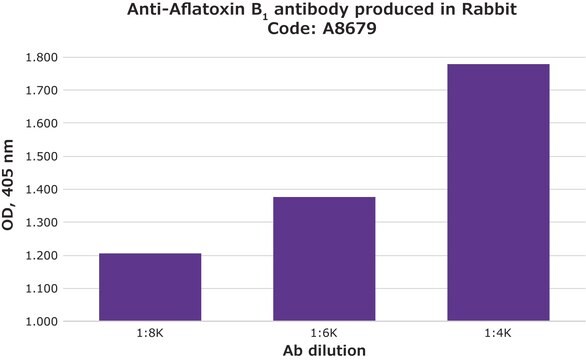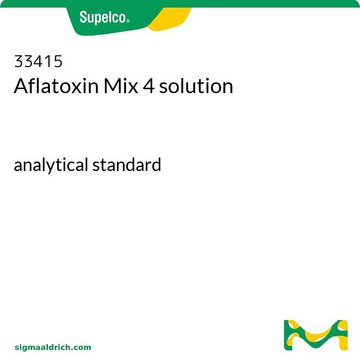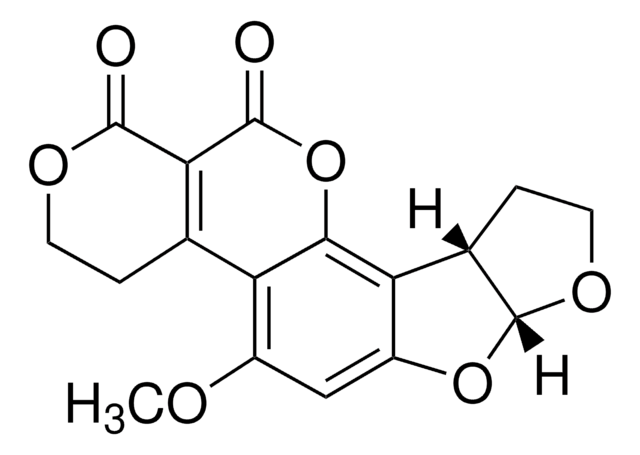A9555
Monoclonal Anti-Aflatoxin B1 (G1, Q1, B2, G2) antibody produced in mouse
clone AT-B1, ascites fluid
Zaloguj sięWyświetlanie cen organizacyjnych i kontraktowych
About This Item
Polecane produkty
pochodzenie biologiczne
mouse
Poziom jakości
białko sprzężone
unconjugated
forma przeciwciała
ascites fluid
rodzaj przeciwciała
primary antibodies
klon
AT-B1, monoclonal
zawiera
15 mM sodium azide
metody
ELISA: 1:20,000 using aflatoxin B1-BSA
izotyp
IgG1
Warunki transportu
dry ice
temp. przechowywania
−20°C
docelowa modyfikacja potranslacyjna
unmodified
Opis ogólny
Monoclonal anti-Aflatoxin B (mouse IgG1 isotype) is 1 derived from the hybridoma produced by the fusion of mouse myeloma cells and splenocytes from an immunized mouse.Aflatoxins are a group of naturally occurring fungal toxins (mycotoxins) synthesized by Aspergillus flavus and Aspergillus parasiticus. It is found as contaminants in human and animal food such as corn, peanuts, tree nuts, cottonseed, cereal crops, beans, casssava, milo, sorghum, copra, rice, dried fish and beer.
Immunogen
aflatoxin B -KLH conjugate
Zastosowanie
Monoclonal Anti-Aflatoxin B1 (G1, Q1, B2, G2) antibody produced in mouse has been used in indirect enzyme linked immunosorbent assay (ELISA) and fluorescence polarization assay.
Działania biochem./fizjol.
Aflatoxin B (AFB) and its metabolites is known to act as potent carcinogens, mutagens and teratogens, in addition to its toxicity. Aflatoxins have been implicated in human hepatocellular carcinoma, outbreaks of aflatoxicosis, Rey′s syndrome, chronic hepatitis and increased mortality from infection in animal husbandry.
Opis wartości docelowych
Mycotoxins, a group of chemically diverse secondary fungal metabolites, induce a variety of toxic responses in humans and animals when food and feed containing these compounds are ingested. Rapidly quantitating levels of mycotoxin contamination can help reduce exposure to these toxins.
Oświadczenie o zrzeczeniu się odpowiedzialności
Unless otherwise stated in our catalog or other company documentation accompanying the product(s), our products are intended for research use only and are not to be used for any other purpose, which includes but is not limited to, unauthorized commercial uses, in vitro diagnostic uses, ex vivo or in vivo therapeutic uses or any type of consumption or application to humans or animals.
Ta strona może zawierać tekst przetłumaczony maszynowo.
Nie możesz znaleźć właściwego produktu?
Wypróbuj nasz Narzędzie selektora produktów.
Kod klasy składowania
10 - Combustible liquids
Klasa zagrożenia wodnego (WGK)
WGK 3
Temperatura zapłonu (°F)
Not applicable
Temperatura zapłonu (°C)
Not applicable
Wybierz jedną z najnowszych wersji:
Masz już ten produkt?
Dokumenty związane z niedawno zakupionymi produktami zostały zamieszczone w Bibliotece dokumentów.
Klienci oglądali również te produkty
Development of a fluorescence polarization assay for the determination of aflatoxins in grains
Nasir MS and Jolley ME
Journal of Agricultural and Food Chemistry, 50(11), 3116-3121 (2002)
Mycotoxins
Bennett JW, et al.
Clinical Microbiology Reviews, 16(3), 497-497 (2003)
Physicochemical and immunological characterization of chitosan-coated bacteriophage nanoparticles for in vivo mycotoxin modeling
de Andrade CYT, et al.
Carbohydrate Polymers, 185, 63-72 (2018)
Robert J Lee et al.
Scientific reports, 6, 33221-33221 (2016-09-15)
Aflatoxins are mycotoxins secreted by Aspergillus flavus, which can colonize the respiratory tract and cause fungal rhinosinusitis or bronchopulmonary aspergillosis. A. flavus is the second leading cause of invasive aspergillosis worldwide. Because many respiratory pathogens secrete toxins to impair mucociliary
Screening of Lactobacillus casei strains for their ability to bind aflatoxin B1
Hernandez MA, et al.
Food And Chemical Toxicology, 47(6), 1064-1068 (2009)
Nasz zespół naukowców ma doświadczenie we wszystkich obszarach badań, w tym w naukach przyrodniczych, materiałoznawstwie, syntezie chemicznej, chromatografii, analityce i wielu innych dziedzinach.
Skontaktuj się z zespołem ds. pomocy technicznej








